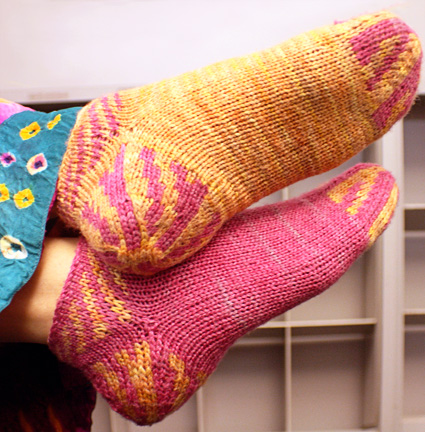

|
|
|

Sun-Speckled Socklets for the first blush of spring. I've been designing Turkish-inspired socks for years. It's true that they are traditionally knit from the toe up. However, I keep hearing myself explain that afterthought heels, common to Turkish sock knitting, can be inserted into both top-down and toe-up sock structures. It was time to design a top-down sock with a Turkish accent! This top-down socklet features almost-matching toes and heels. The toe is shaped as a standard-decrease swirl. This variation on the Crystal Heel echoes its color and swirl patterning, but is shaped with facets to better fit your foot. Stranded colorwork adds reinforcement and style in the places socks can use it most. |
||

|
Tweet
 |
|
|
SIZE |
|
|
FINISHED MEASUREMENTS |
|
MATERIALS Notions |
|
GAUGE |
| 28 sts/40 rounds = 4 inches in stockinette stitch using smaller needles 28 sts/40 rounds = 4 inches in stranded knitting using larger needles |
|
PATTERN NOTES |
|
Because stranded colorwork is less stretchy than one-color knitting, this pattern uses a larger needle size for the colorwork sections. It is important that the leg portion stretches sufficiently to pull on over the heel of your foot. The stranded-knitting stitches should be able to stretch on the needle, resting at least as far apart as your needle is wide. It is good practice at first, to knit perhaps 8-16 stitches and then stop and stretch them on the needle before proceeding. Make sure the unused strands of yarn on the inside of the sock are relaxed enough to allow this desired stretch. If you are new to knitting with two colors in the same round, hold the yarns any way which is comfortable to you. There are strong opinions on the "best" way to do it, but the same fabric will result whether you hold one color in either hand or control both colors with the same hand. If you typically knit by dropping the yarn in between making stitches, I suggest just dropping the unused yarn and picking up the new color as needed. If you do this, don't twist the yarns around each other -- When picking up the heel stitches, using needles one or two sizes smaller than your working needle to pick up stitches can help ease the process. Remember to start knitting the first round of the heel with your regular-sized needle. Grafting: Instructions for grafting can be found here. |
|
|
DIRECTIONS Note: This cast on can and should be begun without a knot. Just hold the yarn against the needle where you would normally place the knot's loop. This avoids a bump in your sock, which might make it uncomfortable when wearing. Leg Heel setup: Foot Toe Using MC, graft toe closed. Note: If you turn the sock upside down to pick up some sts, you may end up with one extra st, which you can decrease away during the first knit rnd. Round 1: [K12[13, 14, 15, 16], pm] 3 times, k to end of round. Change to larger ndls and join CC. Work Heel chart, repeating 4 times for each round, decreasing as indicated, until chart is complete. Using MC, graft heel closed. |
|
FINISHING |
| ABOUT THE DESIGNER |
|
ColorJoy LynnH has been obsessed with color since childhood, and socks since the wildly-colorful '70s. In 2001 she discovered one could knit her own socks. Life changed. Lynn focuses on stranded colorwork (Turkish Socks, Andean Hats and more). The more colors, the better! In 2012, Lynn was commissioned to conceive and coordinate a Yarn Bombing at Michigan State University Horticultural Gardens... her most knitting fun thus far! Lynn was honored to teach at Sock Summit 2011 (including Turkish Socks and Crystal Heels). She has a design in the book Joy of Socks, and has been published in KnitCircus, CraftSanity Magazine, MagKnits and Heels & Toes Gazette. Sometimes she also sings with her husband Brian Hefferan at Ukulele Festivals & more, as The Fabulous Heftones. Visit LynnH's website. |
|
Pattern & images © 2013 Lynn DT Hershberger, AKA ColorJoy LynnH. Contact Lynn |